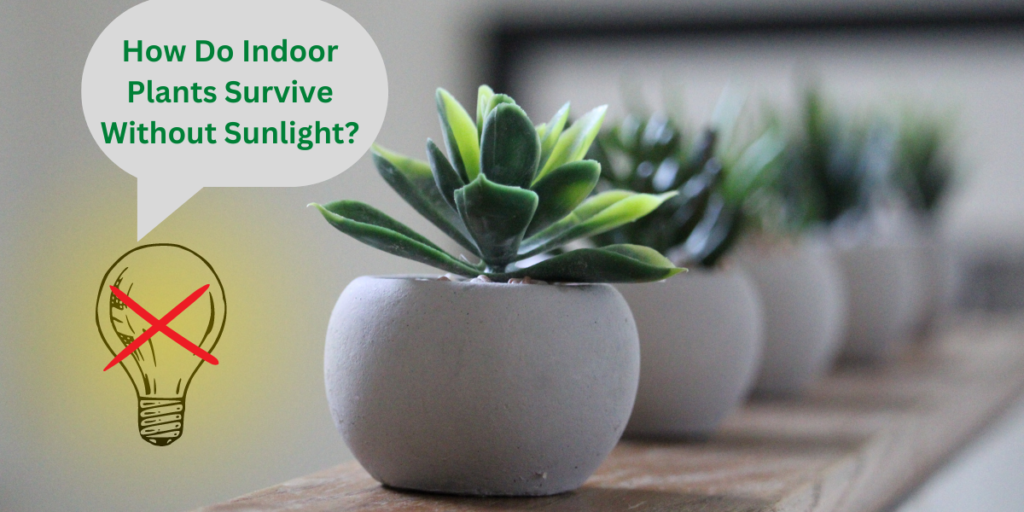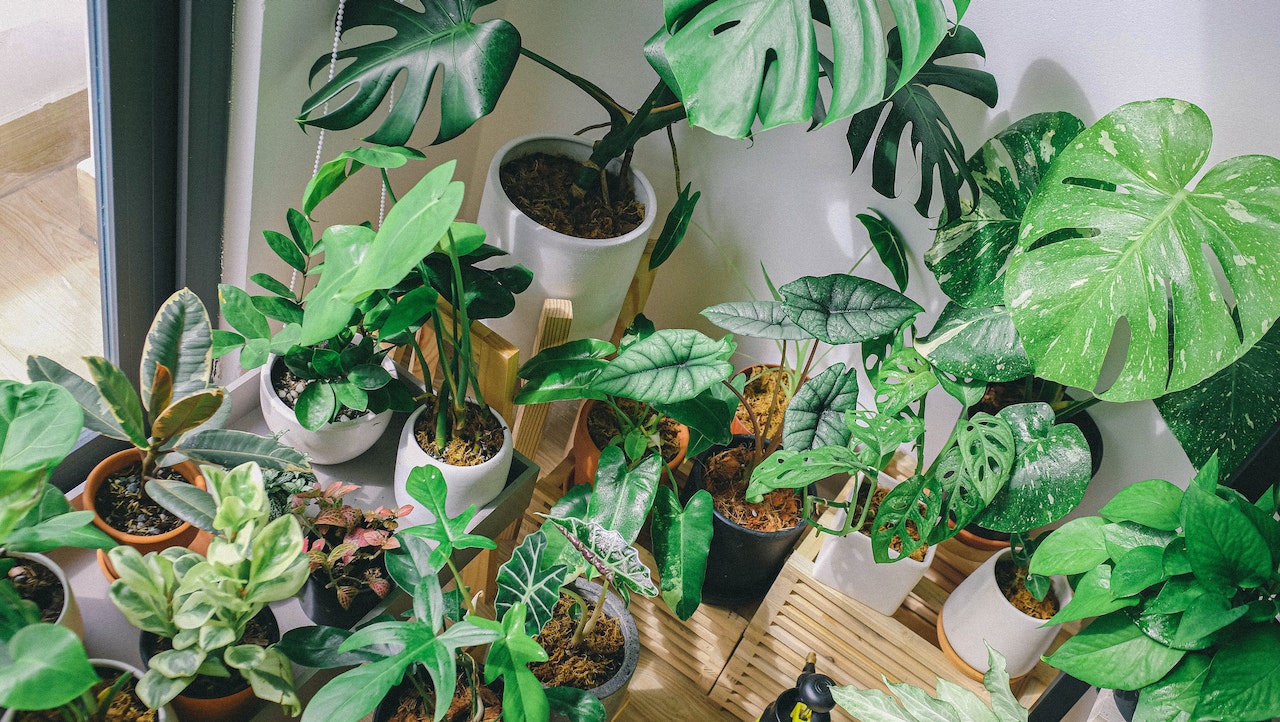Indoor plants are a great way to add some life to your home without spending a lot of money.
Indoor plants are a popular housewarming gift because they add colour and life to a room without taking up much space. Indoor plants are also a great way to brighten up your home!
But have you ever heard of an indoor plant that survives without sunlight? Do you wonder how do indoor plants survive without sunlight?
How do Indoor Plants Survive Without Sunlight?
Most people think that indoor plants need sunlight to survive; however, this is not always the case. There are a variety of plants that can thrive in low or no light conditions. In fact, many indoor plants do not need any direct sunlight at all and will grow just fine in a shady spot near a window.
One common misconception is that all plants need sunlight to produce chlorophyll. While this is true for some plants, others can produce their own food without sunlight. These plants are known as autotrophs and include mosses, liverworts, and certain ferns.
There are also a number of houseplants that don’t need much light but do need some indirect sunlight every day. These plants should be placed near a window where they will get some natural light but won’t be in direct sunlight. Indoor plants are often purchased in pots and placed in the room with their pots on a table, shelf or other suitable location. The amount of light they receive is dependent on the type of plant as well as the size of the pot. However, be assured that even the most demanding plants will adapt and grow to enjoy their new home.
How Can I Make Sure My Plant is Getting Proper Light?

Lighting for houseplants is not an exact science, but there are several things you can do to ensure your plant receives proper light. One of the first things to consider when providing light for houseplants is its intensity. This can be measured in foot-candles (FC), which is a measure of the amount of light that falls on a surface area of one square foot.
The common rule of thumb is that light should fall on a plant at around 6 FC. That’s equivalent to the amount of light falling on your hand in a darkened room. If you are growing houseplants for the first time, you can use this guide to determine how many of your plants should receive 6 FC of light. You can also use this guide to determine how many of your plants should receive 12 FC of light. To calculate the number of lamps you need for a specific area, divide the square footage by 6 and multiply by 12.
Can Indoor Plants Live Without sunlight?
The answer to this question is yes, but there are some things you need to take into consideration. Most plants need sunlight in order to photosynthesize and produce energy, but there are a few plants that can live without sunlight. These plants get their energy from the process of respiration, which occurs when they take in carbon dioxide from the air.
If you want to grow plants indoors that don’t need sunlight, you’ll need to provide them with another source of light. This can be done with artificial lights or by placing the plants near a window that gets plenty of sunlight. You can also grow plants in a greenhouse, which will allow them to get natural sunlight even if you’re living in a place where the sun doesn’t shine very often.
How Do You Keep Plants Alive in a Dark House?
If you are someone who lives in a home where the curtains are always drawn and the lights are never turned on, you may be wondering how to keep plants alive. It can be difficult to provide enough light for plants to grow properly in a dark home, but with a few simple tips, it is possible.
The first thing you need to do is find a spot in your home where the sun shines in. Plants need sunlight to photosynthesize and create energy, so try to find a spot near a window where they will get at least four hours of direct sunlight each day.
If that is not possible, you can also buy grow lights that simulate sunlight. These can be found at most garden stores or online, and they are relatively affordable. Place the grow lights near your plants and make sure they are turned on for at least eight hours each day.
You can also use a mirror to reflect sunlight into your plant. Mirrors can be used to reflect light to keep plants alive in a dark room. The mirror should be placed opposite the window so that the lightest possible will be reflected into the plant’s direction. This will help to keep the plants alive by providing them with some light.
Are LED Lights Good for Indoor Plants?
This is a question that many people have been asking, and the answer is yes, they are. LED lights are a great option for growing indoor plants because they provide the correct spectrum of light that plants need to grow.
It is becoming more common for people to have indoor plants in their homes. There are many reasons for this, including the fact that indoor plants can improve air quality. Another reason to consider having indoor plants is that they can help to reduce stress levels. Additionally, indoor plants can add beauty to a home. One of the best ways to take care of indoor plants is to use LED lights. LED lights provide several advantages over other types of lights, including:
-They use less energy than other types of lights. This means that they can help you save money on your electricity bill.
-They generate very little heat, which means that they are safe to use near plants.
-They last longer than other types of lights.
How Far Should LED Grow Lights Be From Plants?
There is no definitive answer to the question of how far LED grow lights should be from plants, as this will vary depending on the specific plants being grown and the type of LED grow light used. However, in general, it is recommended that LED grow lights be kept around 12-18 inches away from plants, in order to provide the optimum level of light intensity and coverage. Additionally, it is important to keep in mind that some LED grow lights are directional, meaning that they need to be pointed directly at the plants in order for them to receive the light. If using a directional LED grow light, it is important to make sure that the light is pointing directly at the plant’s canopy.
FAQs
Can Plants Survive With Artificial Light?
Plants can survive with artificial light if they have the right spectrum of light. Some plants, like succulents, don’t need as much light as other plants. If you don’t have a lot of sunlight, you can supplement it with artificial light.
What Can Replace Sunlight for Plants?
Supplemental artificial light can be used as a substitute for sunlight. This can be done with grow lights, which come in a variety of types.
One type of grow light is an incandescent bulb. These are the same kind of bulbs that are used in regular household lamps. However, they are not as efficient at producing light for plants as other types of grow lights.
Another type of grow light is a fluorescent bulb. These bulbs come in different colors, including blue, red, and white. They are more efficient than incandescent bulbs at producing light for plants and last longer.
A third type of grow light is a LED bulb. LED bulbs produce very little heat, so they are ideal for growing plants indoors.
Conclusion
Indoor plants can survive by relying on other forms of light, such as fluorescent or LED lighting. While this may not be the ideal situation for the plant, it is still possible for them to thrive in an indoor setting. By understanding the specific needs of each plant, you can create an environment that is perfect for their survival.

